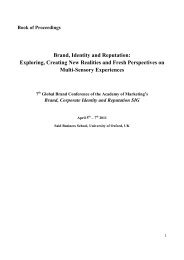You also want an ePaper? Increase the reach of your titles
YUMPU automatically turns print PDFs into web optimized ePapers that Google loves.
(a) (b)<br />
Figure 2.1: (a) Gallic acid and (b) Hexahydroxydiphenic acid<br />
Source: Winkelmann et al. (2006).<br />
Based on the molecular structures, Khanbabae and Van Ree (2001) suggested that<br />
tannins can be divided into four major groups which are Gallotannins, Ellagitannins,<br />
complex tannins and condensed tannins as show in the Figure 2.3. Their chemical<br />
structures are described as follow:<br />
i. Gallotannins are tannins in which galloyl units or their metadepsidic<br />
derivatives are bound to diverse polyol, catechin and ortriterpenoid units.<br />
ii. Ellagitannins are tannins in which at least two galloyl units are C-C<br />
coupled to each other and not contain a glycosidically link catechin unit.<br />
iii. Complex tannins are tannins in which a catechin unit is bound<br />
glycosidically to a gallotannin or an ellagitannin unit.<br />
iv. Condensed tannins are all oligomeric and polymeric proanthocyanidins<br />
formed by linkage of C-4 of one catechin with C-8 or C-6 of the next<br />
monomeric catechin (Khanbabaee and Van Ree, 2001).<br />
Figure 2.2: Chemical Structure of the different groups of Tannin: (a) Condensed Tannin, (b)<br />
Hydrolyzable Tannin. Source: Winkelmann et al. (2006).<br />
7
















